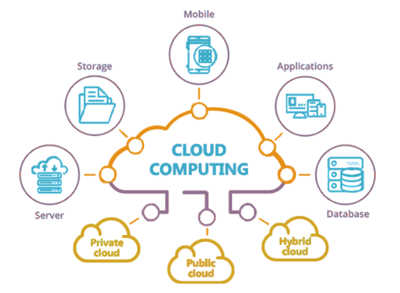Cloud Architecture
Cloud Architecture
Cloud architecture is about the responsibility for overseeing a company's cloud computing strategy ensuring they are making the most of the cloud in a safe, secure and cost efficient way. This includes, cloud adoption plans, cloud application design as well as cloud management and monitoring. Is the way technology components combine to build a cloud, in which resources are pooled through virtualization technology and shared across a network.
Cloud computing architecture is designed in such a way that:
- It solves latency issues and improves data processing requirements
- It reduces IT operating costs and gives good accessibility to access data and digital tools
- It helps businesses to easily scale up and scale down their cloud resources
- It has a flexibility feature which gives businesses a competitive advantage
- It results in better disaster recovery and provides high security
- It automatically updates its services
- It encourages remote working and promotes team collaboration

There are 3 main types of cloud computing services: Infrastructure as-a-Service (IaaS), Platforms-as-a-Service (PaaS) and Software-as-a-Service (SaaS). Integration-as-a-Service (iPaaS) is a new pillar emerging for the integration space and can run across one or more of the cloud computing services combining the different services allowing a seamless integration between applications.

Cloud computing architecture gives an environment where organizations can securely build applications and use cloud services based on the client requirements. And that is where we can come in as getting your cloud services right can make an enormous difference to the efficiency, productivity of your business which is where Data Engineers can help navigate through the complexities and pitfalls of the Azure Platform.
With an ever-expanding range of options for your cloud services and deployments, it is important to get unbiased, expert advice on the best possible solution for you. Our certified consultants can work with you from start to finish providing guidance on everything from extending your existing infrastructure through to the cloud to migrating your whole system to the cloud.
Cloud Migration & Cloud Re-Engineering
When an organization decides it needs to adopt cloud to make a difference to the efficiency and productivity of your business its easy to forget that its not just technical shift but a cultural shift as well.
When designing solutions the traditional way of doing things on premise need to be re-considered with a cloud mindset. There are new ways to achieve the same outcome using new technologies which may not been possible with previously due to cost factors. Just because we have done something this way previously doesn’t mean it has to be the same way tomorrow. Moving to the cloud allows an organization to take advantage of different cost models and scalability.
Cloud migration comes in multiple shapes from a hybrid approach to lift and shift to being cloud native taking advantage of what a cloud can provide.
At Data Engineers we have adopted the use of the Cloud Adoption Framework to help accelerate a cloud adoption journey as it provides guidance, best practices, and tools that have been proven from Microsoft.
When embarking on a cloud journey it’s important to work out strategies for adoption which covers off things like
- Governance
- Administration
- Cost Management
- Naming Convention
- Identity Management
- Tagging
- Policies
- Security
These then will help throughout the implementation of any cloud adoption and are easier to think about and implement at the start rather than down the track.
When it comes to cloud adoption, many organizations choose to leave some of their resources on-premises data center and only move a portion of them to the cloud creating a hybrid cloud. This could be for a variety of reasons including taking advantage of existing infrastructure as well as allowing organizations to meet industry and governmental compliance requirements.
When adopting the cloud, it's within the planning phase to look at each application that you currently have and deciding the appropriate approach. Using the 5 R’s of Rationalization for each application is worth its weight in Gold
- Rehost
- Refactor
- Rearchitect
- Rebuild
- Replace
However, moving down the list increases the duration of migration and associated costs due to work needing to be done on a given application.
When building bespoke applications it's important to take advantage of native cloud features such as authentication and logging rather than having to write frameworks yourself to do the same thing. In the last 7 years Platform As a Service (PaaS) has come a long way and many things how we develop against the features have changed such as exposed surface area such as Storage and database connectivity can be contained within your own network rather than over the public internet.
Data Engineers have experienced certified consultants who are able to help guide you through the process.
